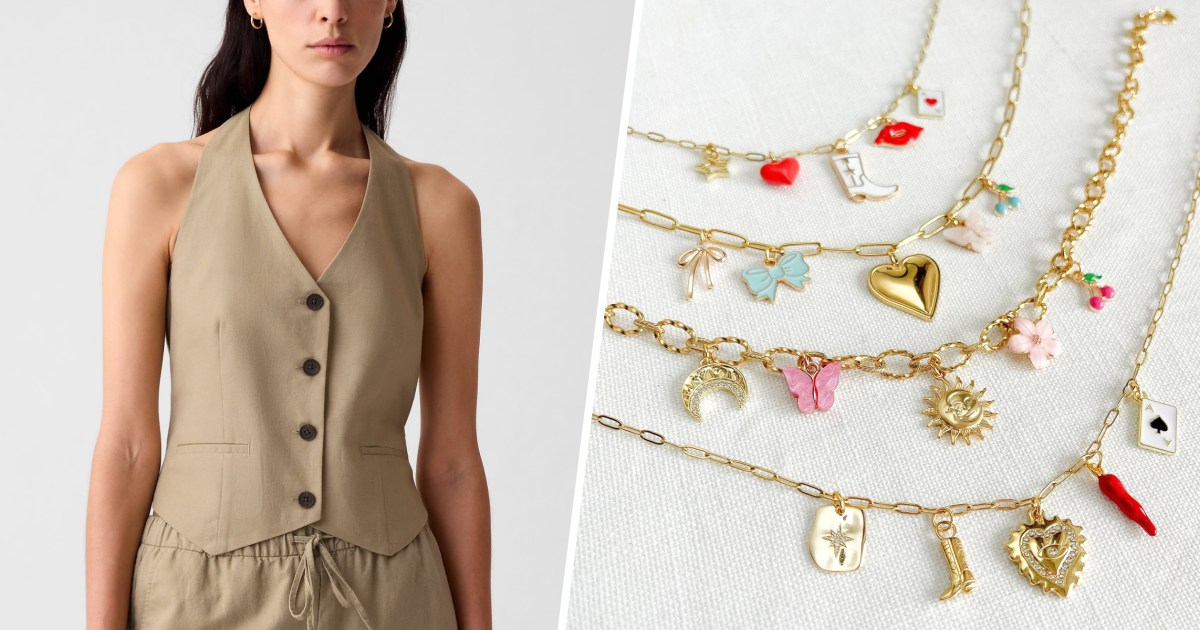A TikTok spokesperson highlighted social commerce is booming in the UK and predicts it will more than double in the next four years. Credit: Shutterstock.
The world of fashion retail experienced a seismic shift with the advent and rise of online shopping. Fast forward to today and social media platforms like TikTok are successfully bringing fashion consumers together as part of live shopping broadcasts with models and influencers trying clothes, footwear and accessories in real time.
With over 63 million posts tagged #fashion on TikTok alone, such platforms are not just influencing how consumers discover and purchase fashion items, but they are also reshaping the entire fashion retail landscape.
Research conducted by intelligence company Morning Consult found millennials are the “most consistent” social media shoppers, using shopping features on all platforms at higher rates than the rest of the population, particularly Facebook and YouTube.
In line with this trend, Gen Z adults were found to be using shopping features on other apps at similar rates as millennials, well ahead of older generations.
The report also revealed that even though Gen Z are the biggest demographic using TikTok, millennials are more likely to have used TikTok Shop relative to their platform usage with 37% of millennials claiming to have made a purchase on TikTok Shop.
A spokesperson from TikTok Shop told Just Style that its users lead the way in social commerce penetration, with 44% having made a purchase directly on TikTok, and one in four purchasing on the platform at least once a month.
Access the most comprehensive Company Profiles
on the market, powered by GlobalData. Save hours of research. Gain competitive edge.
View profiles in store

Company Profile – free
sample
Your download email will arrive shortly
We are confident about the
unique
quality of our Company Profiles. However, we want you to make the most
beneficial
decision for your business, so we offer a free sample that you can download by
submitting the below form
By GlobalData
Country *
UK
USA
Afghanistan
Åland Islands
Albania
Algeria
American Samoa
Andorra
Angola
Anguilla
Antarctica
Antigua and Barbuda
Argentina
Armenia
Aruba
Australia
Austria
Azerbaijan
Bahamas
Bahrain
Bangladesh
Barbados
Belarus
Belgium
Belize
Benin
Bermuda
Bhutan
Bolivia
Bonaire, Sint
Eustatius
and
Saba
Bosnia and Herzegovina
Botswana
Bouvet Island
Brazil
British Indian Ocean
Territory
Brunei Darussalam
Bulgaria
Burkina Faso
Burundi
Cambodia
Cameroon
Canada
Cape Verde
Cayman Islands
Central African Republic
Chad
Chile
China
Christmas Island
Cocos Islands
Colombia
Comoros
Congo
Democratic Republic
of
the Congo
Cook Islands
Costa Rica
Côte d”Ivoire
Croatia
Cuba
Curaçao
Cyprus
Czech Republic
Denmark
Djibouti
Dominica
Dominican Republic
Ecuador
Egypt
El Salvador
Equatorial Guinea
Eritrea
Estonia
Ethiopia
Falkland Islands
Faroe Islands
Fiji
Finland
France
French Guiana
French Polynesia
French Southern
Territories
Gabon
Gambia
Georgia
Germany
Ghana
Gibraltar
Greece
Greenland
Grenada
Guadeloupe
Guam
Guatemala
Guernsey
Guinea
Guinea-Bissau
Guyana
Haiti
Heard Island and
McDonald
Islands
Holy See
Honduras
Hong Kong
Hungary
Iceland
India
Indonesia
Iran
Iraq
Ireland
Isle of Man
Israel
Italy
Jamaica
Japan
Jersey
Jordan
Kazakhstan
Kenya
Kiribati
North Korea
South Korea
Kuwait
Kyrgyzstan
Lao
Latvia
Lebanon
Lesotho
Liberia
Libyan Arab Jamahiriya
Liechtenstein
Lithuania
Luxembourg
Macao
Macedonia,
The
Former
Yugoslav Republic of
Madagascar
Malawi
Malaysia
Maldives
Mali
Malta
Marshall Islands
Martinique
Mauritania
Mauritius
Mayotte
Mexico
Micronesia
Moldova
Monaco
Mongolia
Montenegro
Montserrat
Morocco
Mozambique
Myanmar
Namibia
Nauru
Nepal
Netherlands
New Caledonia
New Zealand
Nicaragua
Niger
Nigeria
Niue
Norfolk Island
Northern Mariana Islands
Norway
Oman
Pakistan
Palau
Palestinian Territory
Panama
Papua New Guinea
Paraguay
Peru
Philippines
Pitcairn
Poland
Portugal
Puerto Rico
Qatar
Réunion
Romania
Russian Federation
Rwanda
Saint
Helena,
Ascension and Tristan da Cunha
Saint Kitts and Nevis
Saint Lucia
Saint Pierre and Miquelon
Saint Vincent and
The
Grenadines
Samoa
San Marino
Sao Tome and Principe
Saudi Arabia
Senegal
Serbia
Seychelles
Sierra Leone
Singapore
Slovakia
Slovenia
Solomon Islands
Somalia
South Africa
South
Georgia
and The South
Sandwich Islands
Spain
Sri Lanka
Sudan
Suriname
Svalbard and Jan Mayen
Swaziland
Sweden
Switzerland
Syrian Arab Republic
Taiwan
Tajikistan
Tanzania
Thailand
Timor-Leste
Togo
Tokelau
Tonga
Trinidad and Tobago
Tunisia
Turkey
Turkmenistan
Turks and Caicos Islands
Tuvalu
Uganda
Ukraine
United Arab Emirates
US Minor Outlying Islands
Uruguay
Uzbekistan
Vanuatu
Venezuela
Vietnam
British Virgin Islands
US Virgin Islands
Wallis and Futuna
Western Sahara
Yemen
Zambia
Zimbabwe
Kosovo
Industry *
Academia & Education
Aerospace, Defense &
Security
Agriculture
Asset Management
Automotive
Banking & Payments
Chemicals
Construction
Consumer
Foodservice
Government, trade bodies
and NGOs
Health & Fitness
Hospitals & Healthcare
HR, Staffing &
Recruitment
Insurance
Investment Banking
Legal Services
Management Consulting
Marketing & Advertising
Media & Publishing
Medical Devices
Mining
Oil & Gas
Packaging
Pharmaceuticals
Power & Utilities
Private Equity
Real Estate
Retail
Sport
Technology
Telecom
Transportation &
Logistics
Travel, Tourism &
Hospitality
Venture Capital
Tick here to opt out of curated industry news, reports, and event updates from Just Style.
Submit and
download
Visit our Privacy Policy for more information about our services, how we may use, process and share your personal data, including information of your rights in respect of your personal data and how you can unsubscribe from future marketing communications. Our services are intended for corporate subscribers and you warrant that the email address submitted is your corporate email address.
This surge in social media fashion shopping is becoming a significant force, impacting everything from brand operations to consumer behaviour.
According to a report by accountancy firm KPMG, Gen Z is spearheading the future growth and trajectory of the retail industry. The report states that “social commerce” is the most popular channel for Gen Z shoppers especially in China, Vietnam, Indonesia and the Philippines.
GlobalData’s retail analyst Chloe Collins broke down what is driving fashion consumers to shop on social media platforms: “Consumers are increasingly relying on platforms like Instagram and TikTok to discover the latest fashion trends and brands, through influencers as well as brands’ own content.”
Collins highlighted the convenience such platforms offer, with in-app purchases aiding conversion once shoppers have seen an item they like.
This is exemplified through TikTok Shop’s ‘discovery e-commerce’ model which a spokesperson from the platform said is “redefining e-commerce.”
The spokesperson said: “This innovative approach offers a seamless, one-stop shopping experience that puts the joy back into shopping. Through a content-first approach and using features such as Tiktok Live, the platform provides businesses and brands with an effective way to promote products ensuring that every interaction is not just a transaction but an opportunity for growth, connection and engagement with their community.”
With platforms like TikTok Shop revolutionising the traditional retail model, GlobalData’s retail analyst Neil Saunders identified two main points of disruption: discovery and buying. Discovery is more established and about people finding fashion and brands and deciding what to buy.
He believes social media does a great job of doing this through direct advertising by brands and by influencers showcasing things they’ve bought or that they like.
What does this mean for the fashion industry?
Saunders views social media as both an opportunity and a complex channel requiring thoughtful integration into business strategies: “Social is another channel fashion retailers and brands need to be conscious of and have a strategy for. Most will at least want to use the platforms to showcase products and new launches, some will want to sell directly.”
He explained that, given the “reasonably strong” margins in fashion, many social media shops will turn a profit. However, as much as Saunders believes in the power of this new avenue, he is quick to point out that margins are often much lower than traditional retail because social marketing and advertising costs are not cheap. Plus, there is the expense of distribution and logistics, and dealing with returns.
Ideally, Saunders envisions social media shopping and traditional brick-and-mortar stores as complementary channels. But is that the case?
He elaborated on how the diversity of the audience and their purpose is a major driver of these two channels. Traditionally, social media has been more about advertising and showcasing products, while stores offer experience and smart fashion brands have used it for the same purpose – to create noise that drives shoppers into stores. Saunders marked this grey area, stressing the importance of effectively overlapping these channels to maximise their potential.
How can fashion brands leverage this new trend?
TikTok’s spokesperson highlighted the booming social commerce industry in the UK, predicting it will more than double in the next four years, rising from £7.4bn ($9.61bn) to almost £16bn by 2028.
“This means that social commerce would become 10% of the total online commerce market, up from 6% today, and growing at four times the rate of overall e-commerce sales,” the spokesperson noted.
TikTok emphasised the ultimate hack to engage with this community is through authentic and engaging content: “Having a content-first approach is the key to success for businesses of all sizes.”
Online fashion retailer ASOS has already embraced this strategy. ASOS told Just Style that it launched a collection of design products on the TikTok Shop in March to ensure it is “showing up in places that are native to its core customer group of fashion-loving 20-somethings.”
This move emphasises the importance of meeting consumers where they are most active and engaged.
Following trends with a hint of caution
Despite agreeing that social media offers a “much more level playing field” for brands, Saunders advises fashion brands to take a cautious approach.
He explains that while bigger brands can buy impressions, it is harder to buy genuine engagement. Small brands that are creative and authentic can garner a lot of attention, potentially going viral and transforming their sales and visibility overnight.
At the same time, he warned brands of the expenses that come with social media marketing, noting how it has become more costly over time.
He added: “It is also a very crowded space, and it can be hard to gain visibility. Social media is also fickle so what’s hot one minute, is out the next. It is also a channel that can backfire: poor campaigns and brands that are seen as out of touch can get criticism hurdled at them on social media.”
Collins, on the other hand, suggested brands use social media not just as a marketing tool but also as a selling channel. She expects social media to become even more dominant as Gen Z ages and gains greater spending power, and Gen Alpha begins to use it heavily too.
The rise of social media platforms for selling has significantly boosted the market for pre-loved goods, giving unwanted items a second life and reducing the overall carbon footprint of retail, according to the UK retail trade association British Retail Consortium (BRC). However, this trend comes with its own set of challenges and risks.
While the increased market for second-hand goods is a positive environmental step, the BRC noted that purchasing from social media platforms often comes with fewer quality guarantees, greater challenges in returning items, and an increased risk of scams compared to established retailers.
The BRC elaborated: “Lesser-known platforms may lack robust data security measures, increasing the risk of financial information theft whereas using reputable websites limits exposure to scams.”
In contrast to these concerns, the TikTok Shop spokesperson emphasised how the platform is focused on creating a shopping experience people love and trust.
“Whether an item is discovered through the For You Page or searched for on the Shop tab, TikTok facilitates safe and secure transactions for a quick, smooth checkout process all within the app,” the spokesperson explained. “Fake or unauthorised replicas of an authentic product are forbidden on TikTok Shop. We have strict IP and counterfeit policies in place which merchants must adhere to. There are thousands of trusted sellers fashion shoppers can explore and discover on TikTok Shop.”
These platforms may offer lucrative new ways for consumers to shop and fashion brands to sell, but they also bring challenges that need to be navigated to ensure a safe and satisfactory experience.




